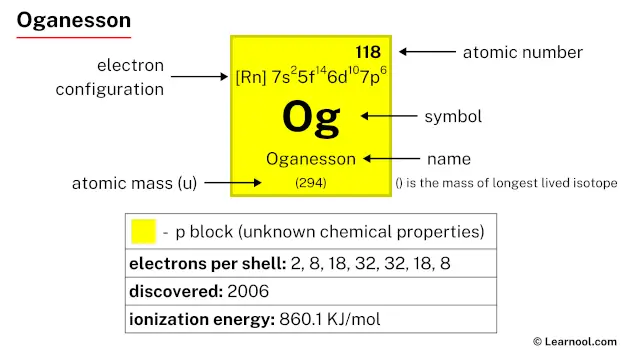
Oganesson (Og) is a chemical element of the periodic table, located in the group 18 and the period 7, and has the atomic number 118. It is named after the Russian nuclear physicist, Yuri Oganessian. It is a member of the noble gas group and is the last element of the 7th period. It is a transuranium element and is counted as one of the radioactive elements.
On periodic table
| group | ⇨ | 1 | 2 | 3 | 4 | 5 | 6 | 7 | 8 | 9 | 10 | 11 | 12 | 13 | 14 | 15 | 16 | 17 | 18 |
| period | ⇩ | ||||||||||||||||||
| 1 | 1 H 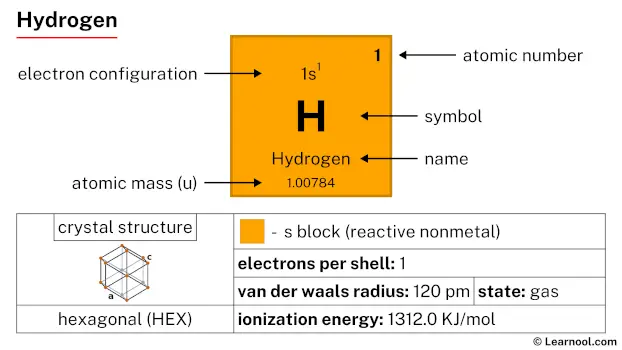 Hydrogen |
2 He  Helium |
|||||||||||||||||
| 2 | 3 Li  Lithium |
4 Be 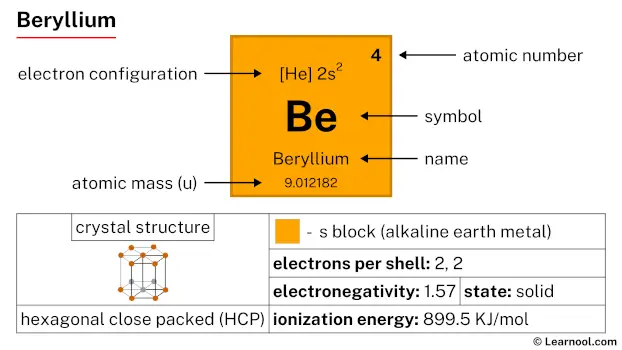 Beryllium |
5 B 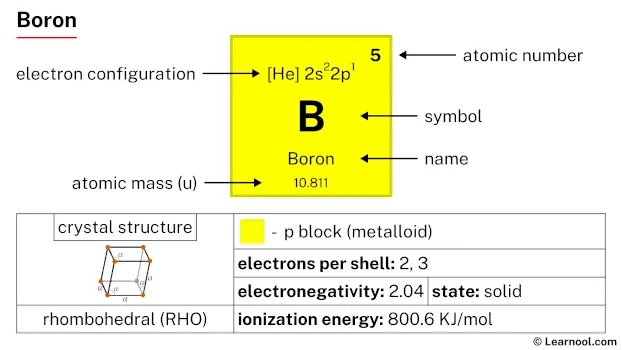 Boron |
6 C  Carbon |
7 N 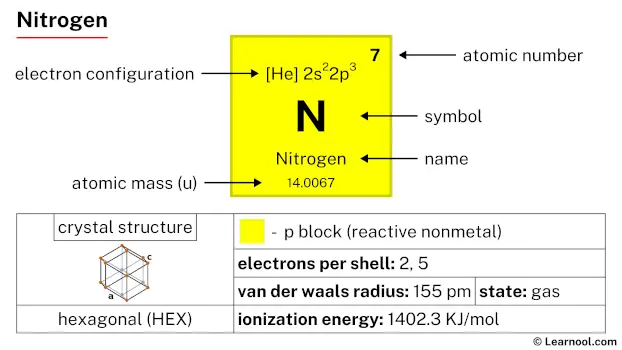 Nitrogen |
8 O 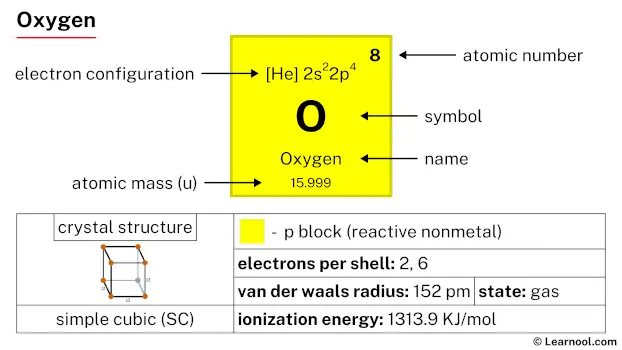 Oxygen |
9 F 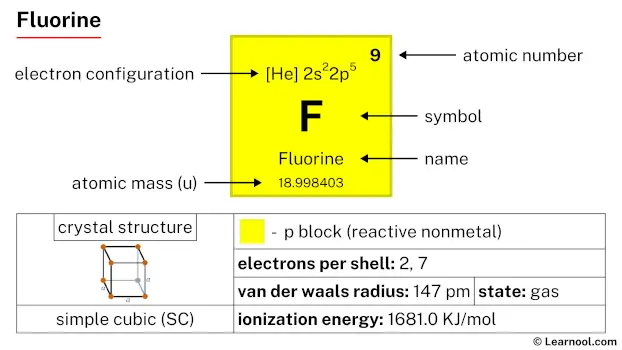 Fluorine |
10 Ne 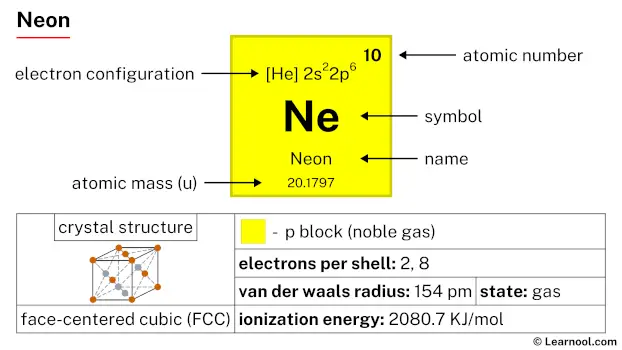 Neon |
|||||||||||
| 3 | 11 Na 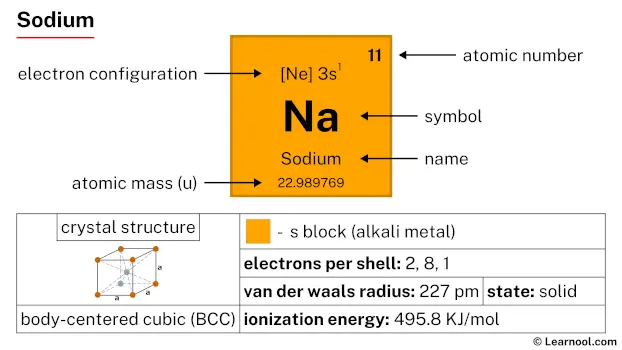 Sodium |
12 Mg 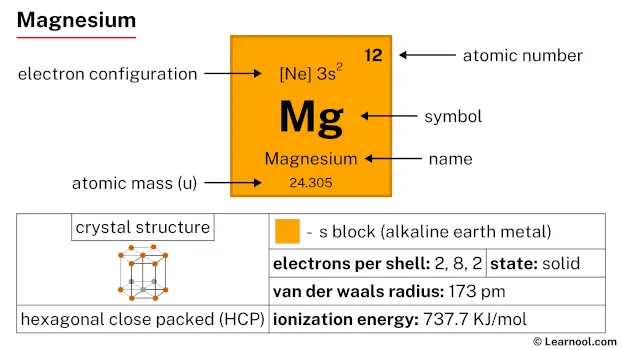 Magnesium |
13 Al  Aluminium |
14 Si Silicon |
15 P 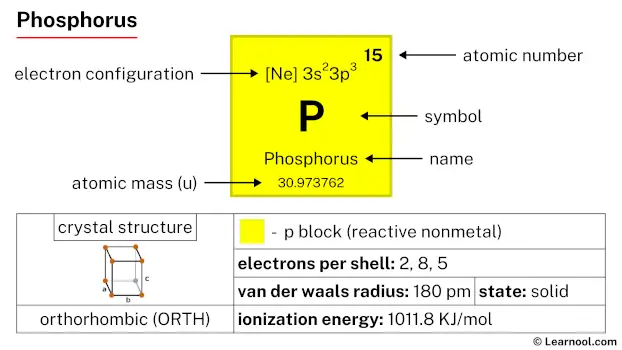 Phosphorus |
16 S 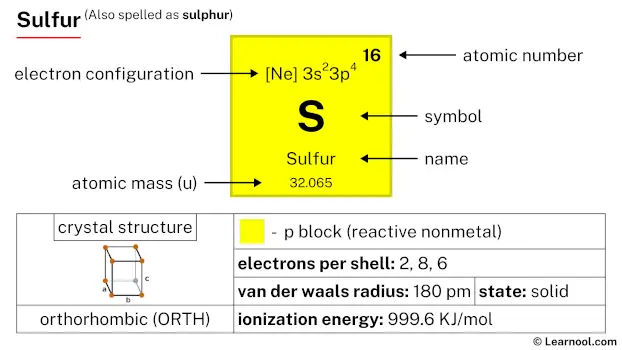 Sulfur |
17 Cl 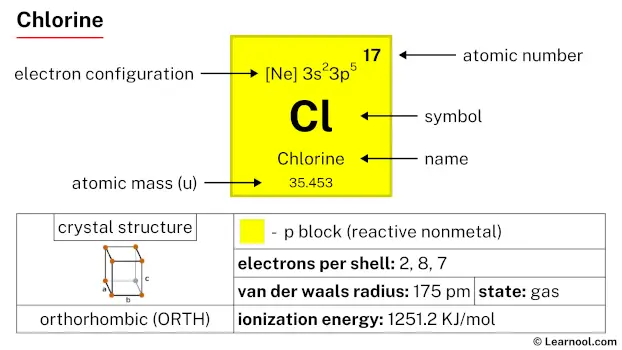 Chlorine |
18 Ar 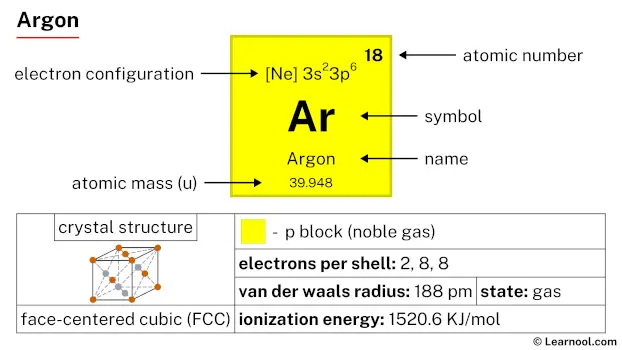 Argon |
|||||||||||
| 4 | 19 K 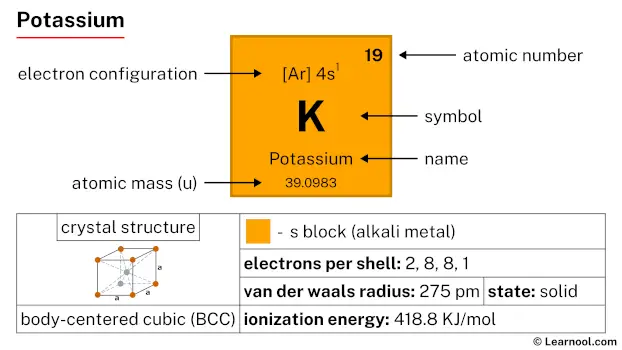 Potassium |
20 Ca 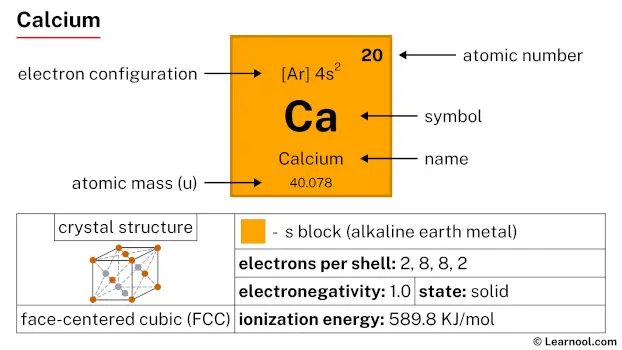 Calcium |
21 Sc 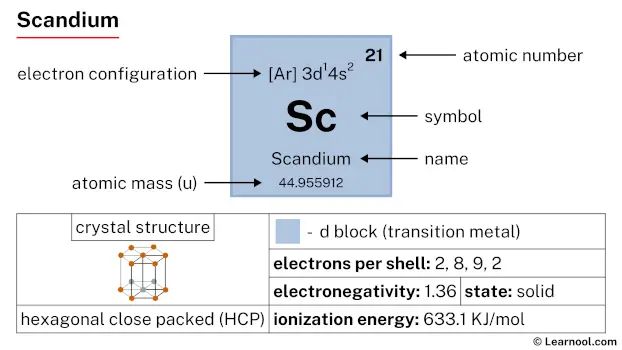 Scandium |
22 Ti 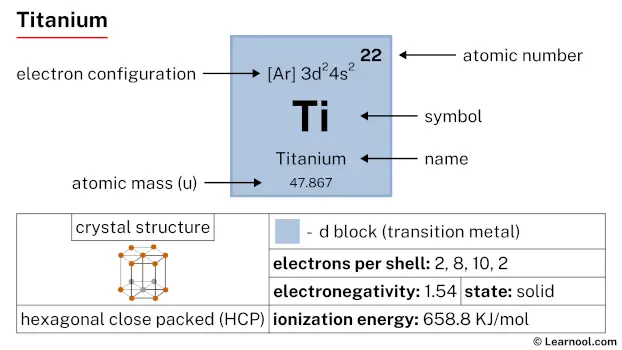 Titanium |
23 V 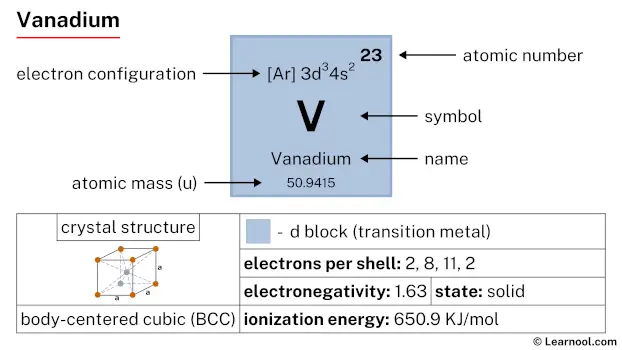 Vanadium |
24 Cr 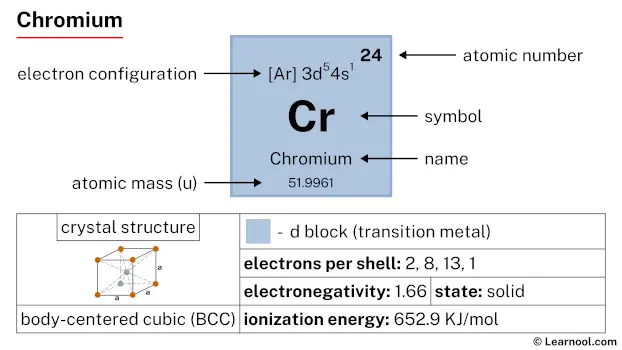 Chromium |
25 Mn 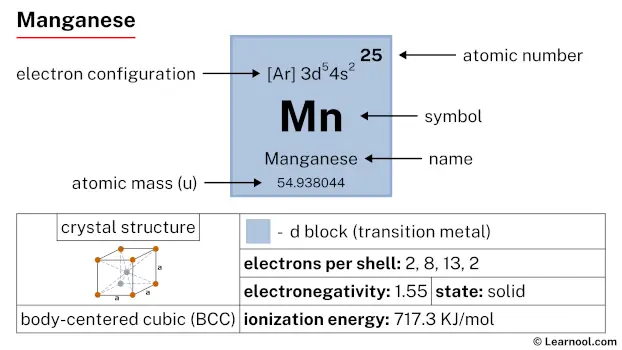 Manganese |
26 Fe 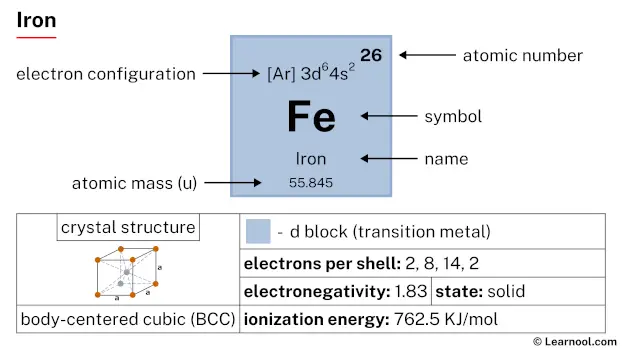 Iron |
27 Co 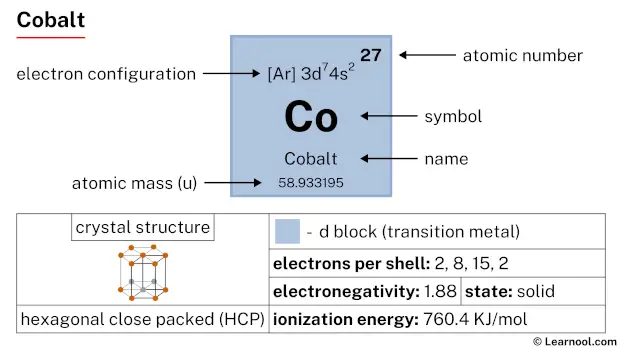 Cobalt |
28 Ni 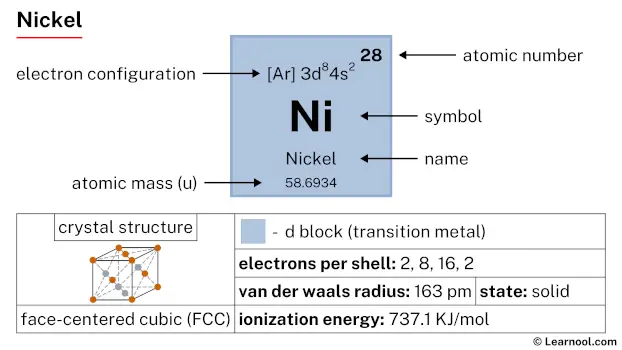 Nickel |
29 Cu 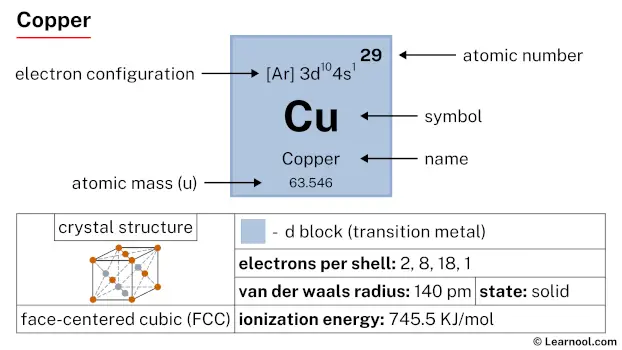 Copper |
30 Zn  Zinc |
31 Ga 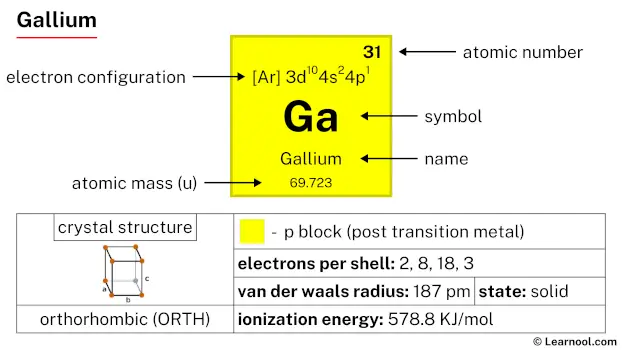 Gallium |
32 Ge 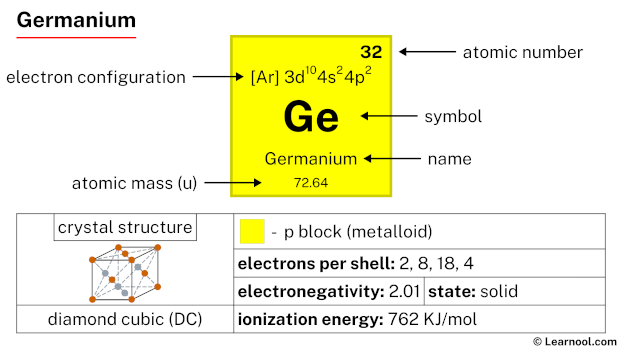 Germanium |
33 As 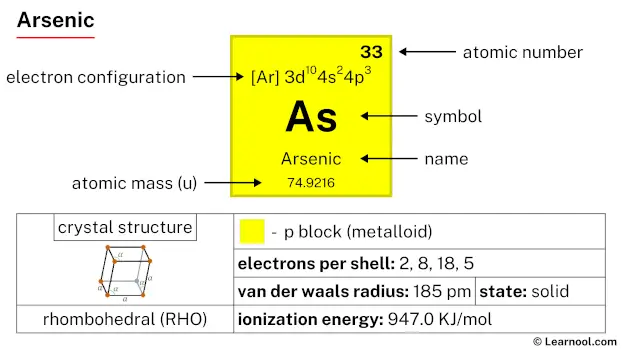 Arsenic |
34 Se 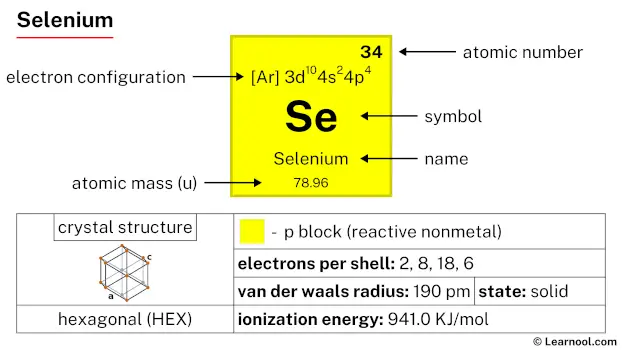 Selenium |
35 Br 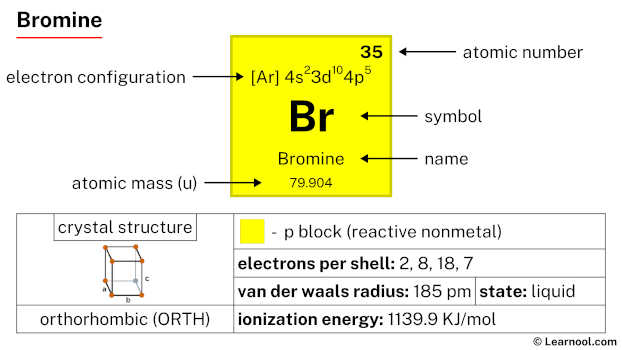 Bromine |
36 Kr  Krypton |
|
| 5 | 37 Rb 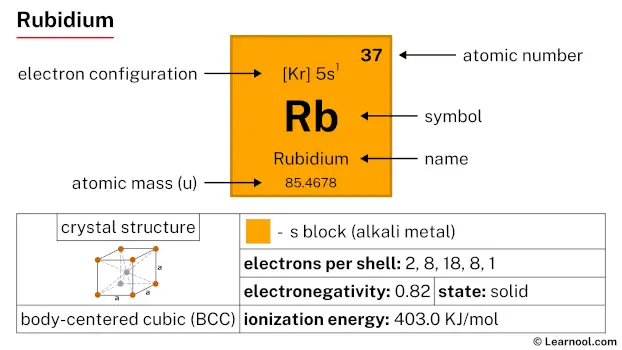 Rubidium |
38 Sr 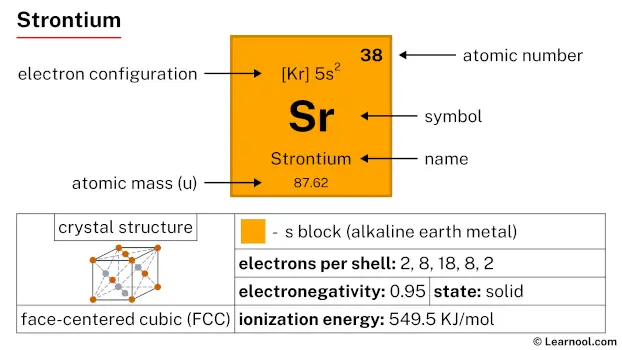 Strontium |
39 Y 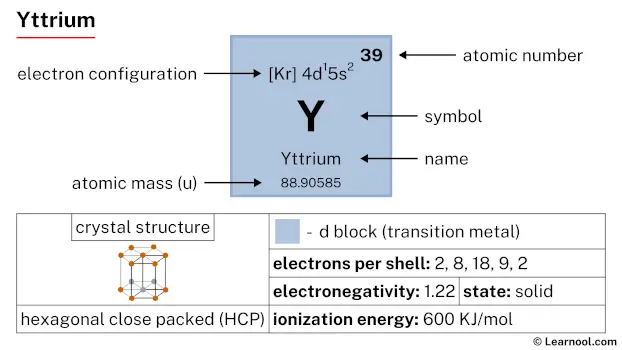 Yttrium |
40 Zr 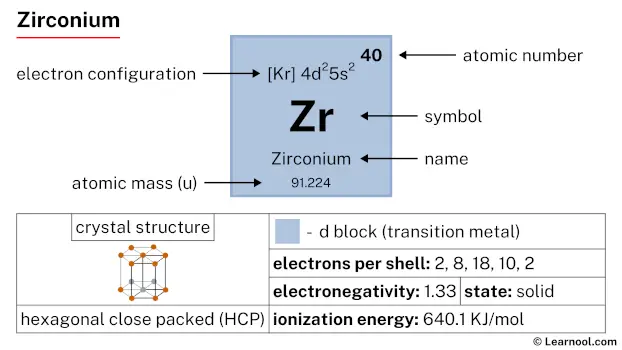 Zirconium |
41 Nb 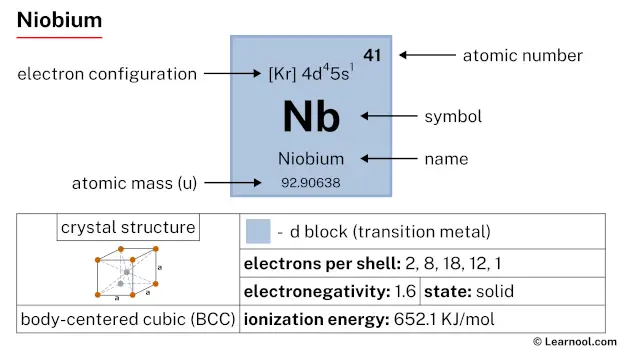 Niobium |
42 Mo 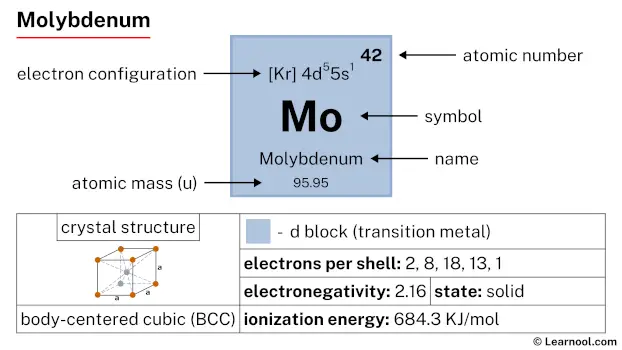 Molybdenum |
43 Tc 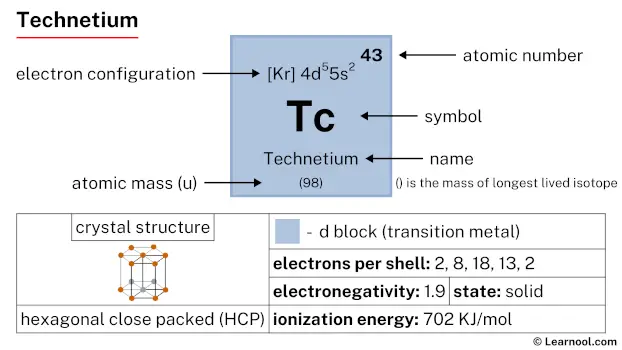 Technetium |
44 Ru 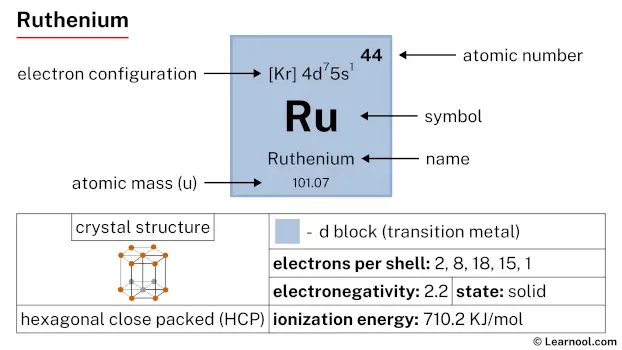 Ruthenium |
45 Rh 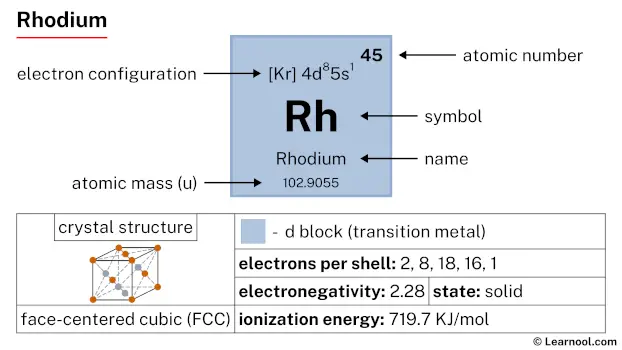 Rhodium |
46 Pd  Palladium |
47 Ag  Silver |
48 Cd 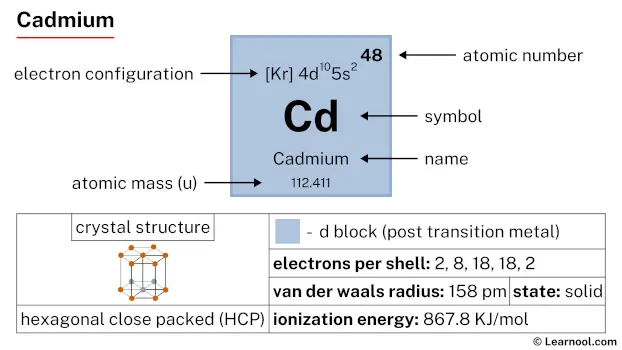 Cadmium |
49 In 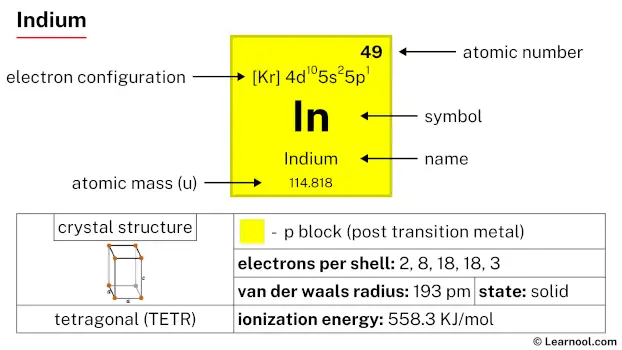 Indium |
50 Sn 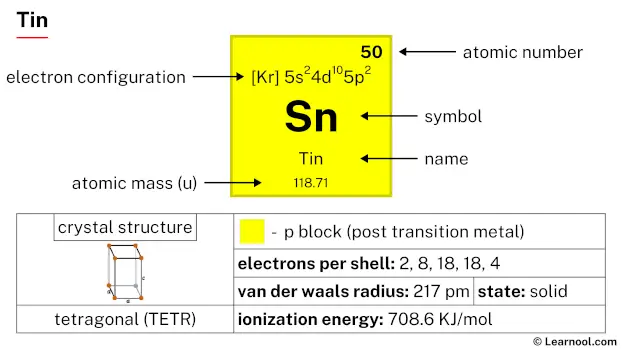 Tin |
51 Sb 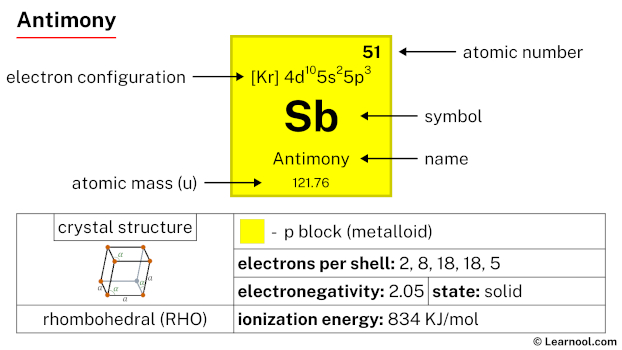 Antimony |
52 Te 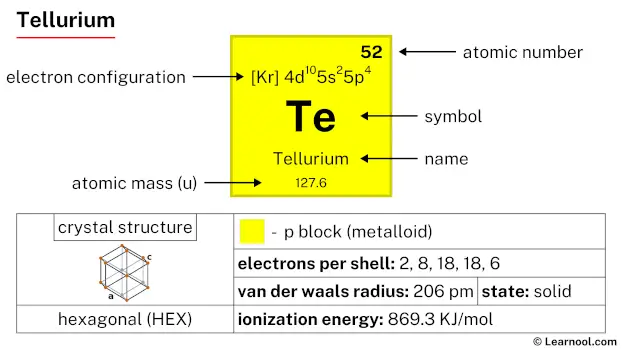 Tellurium |
53 I 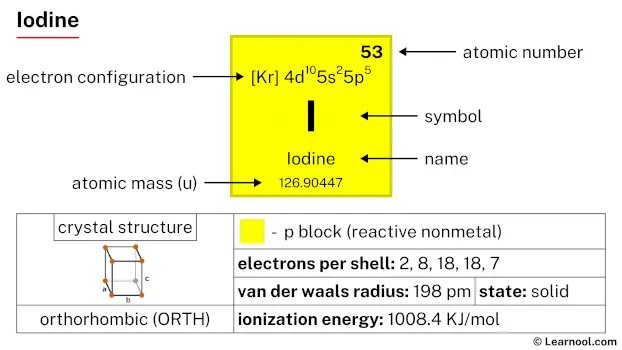 Iodine |
54 Xe 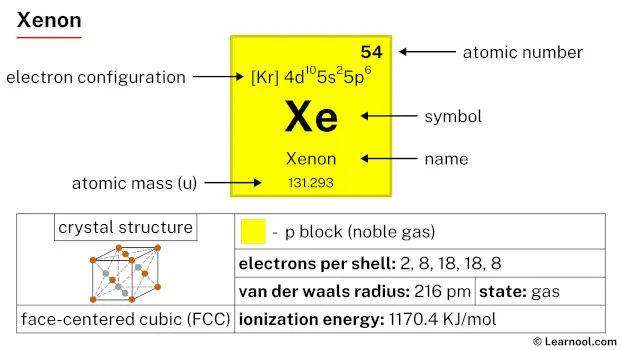 Xenon |
|
| 6 | 55 Cs 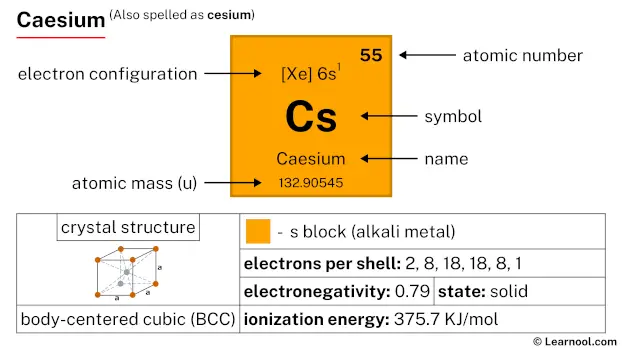 Caesium |
56 Ba 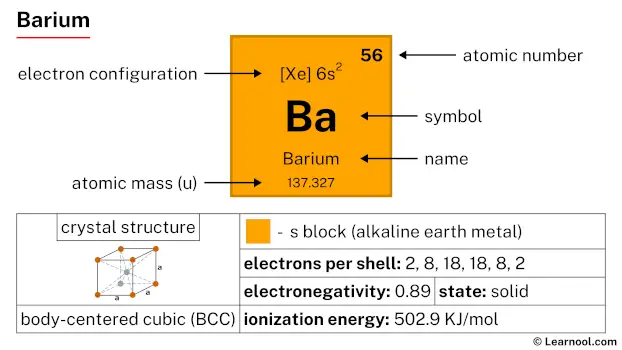 Barium |
72 Hf 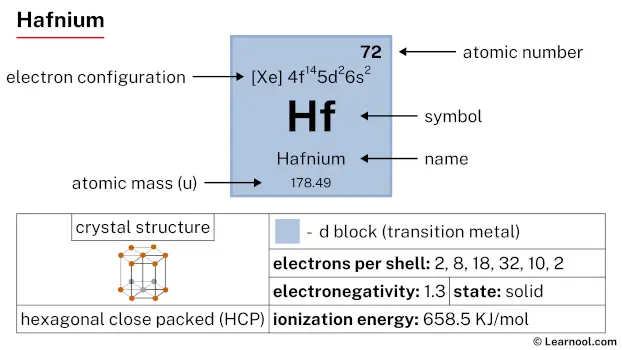 Hafnium |
73 Ta 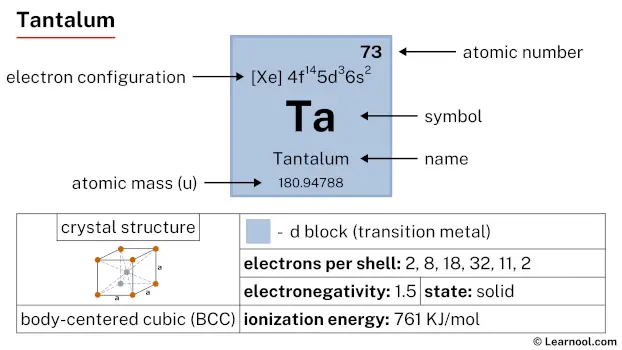 Tantalum |
74 W 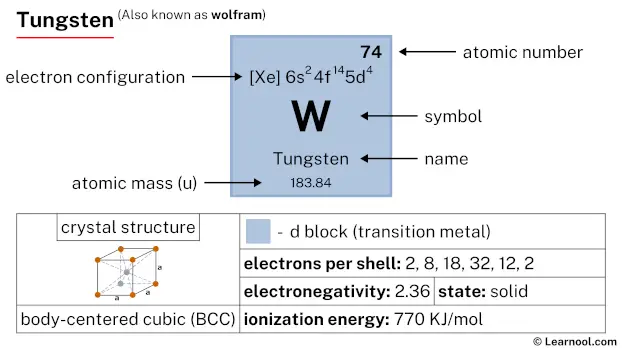 Tungsten |
75 Re 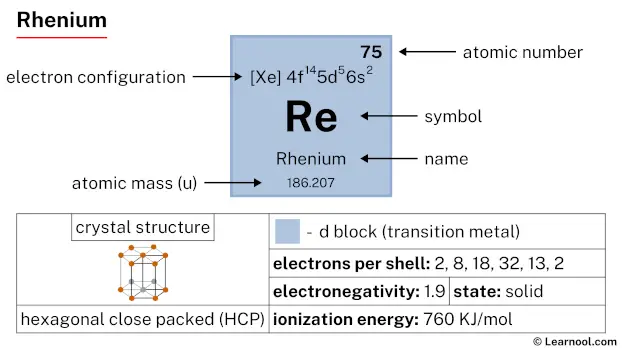 Rhenium |
76 Os 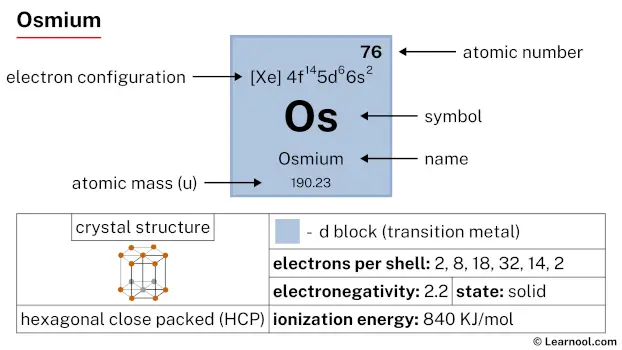 Osmium |
77 Ir 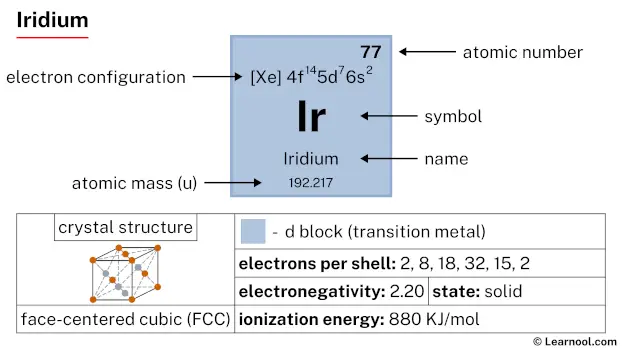 Iridium |
78 Pt  Platinum |
79 Au  Gold |
80 Hg 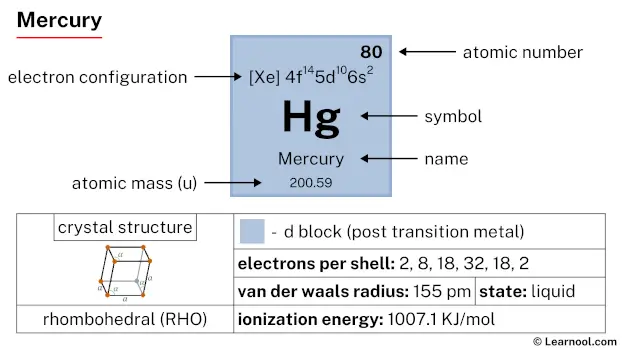 Mercury |
81 Tl 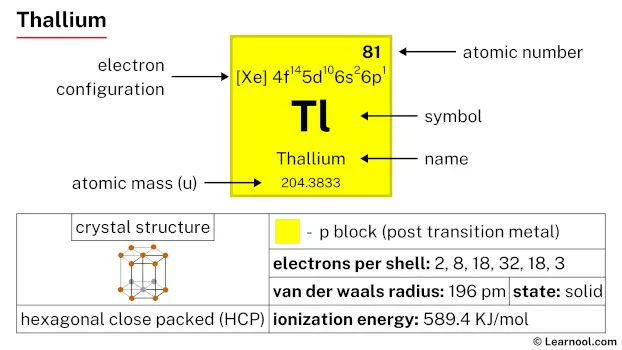 Thallium |
82 Pb  Lead |
83 Bi 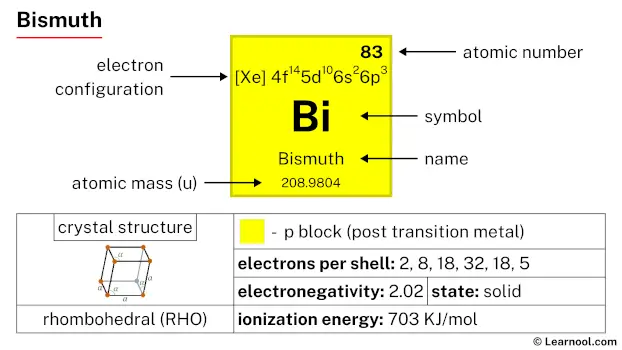 Bismuth |
84 Po 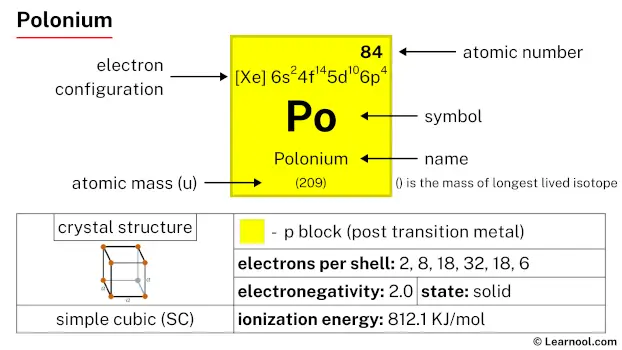 Polonium |
85 At 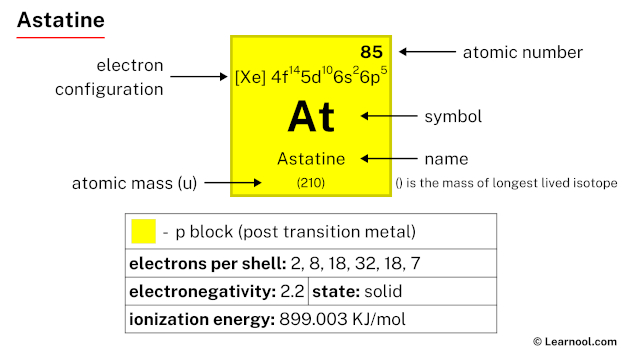 Astatine |
86 Rn 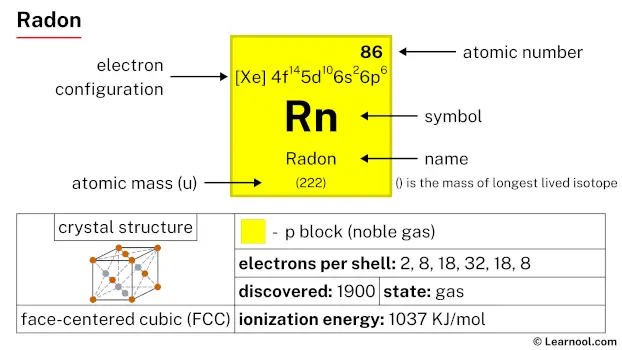 Radon |
||
| 7 | 87 Fr 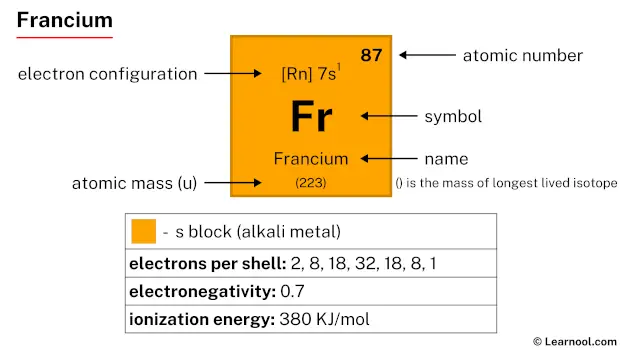 Francium |
88 Ra 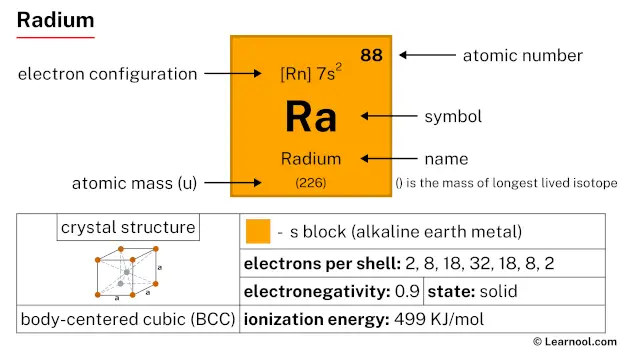 Radium |
104 Rf 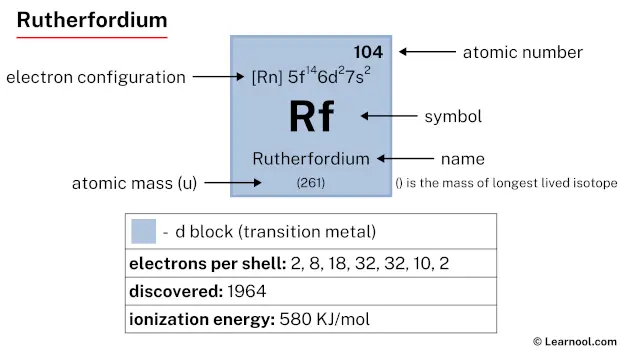 Rutherfordium |
105 Db 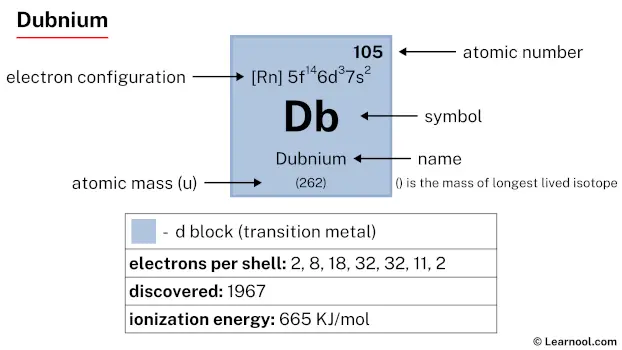 Dubnium |
106 Sg 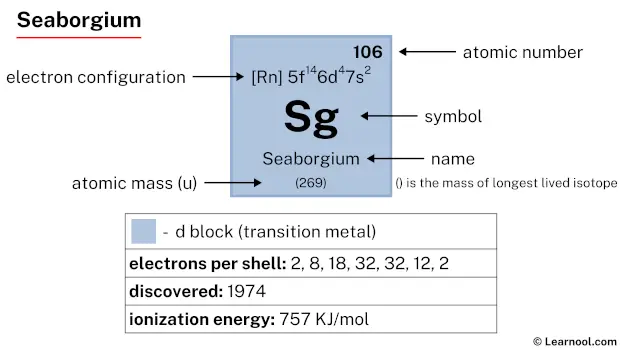 Seaborgium |
107 Bh 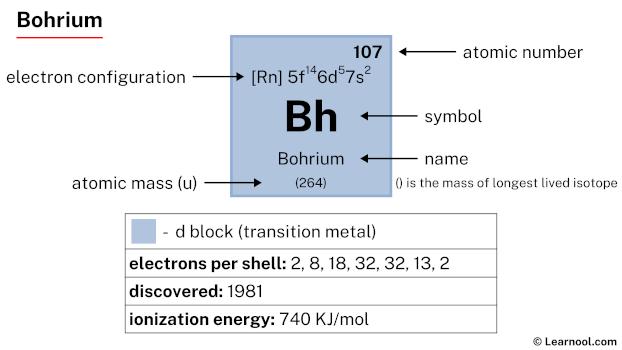 Bohrium |
108 Hs 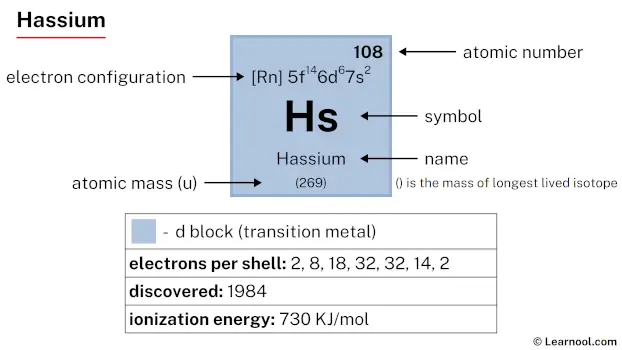 Hassium |
109 Mt 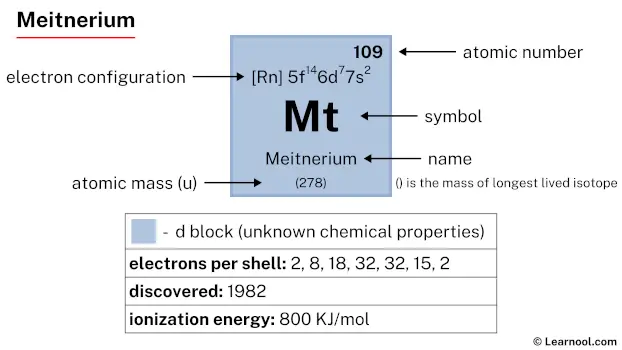 Meitnerium |
110 Ds 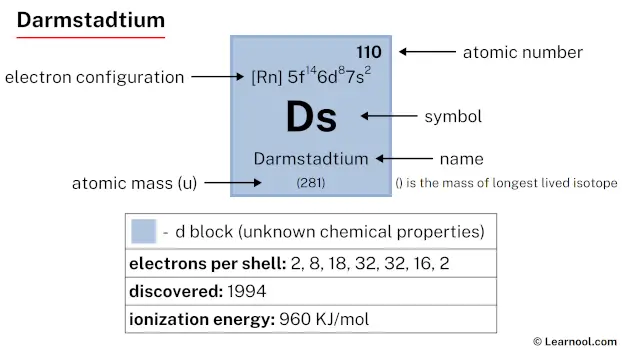 Darmstadtium |
111 Rg 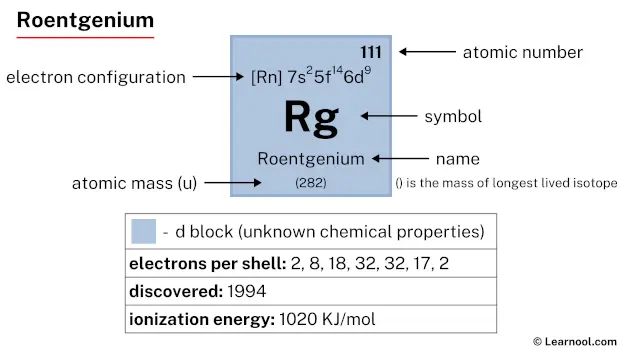 Roentgenium |
112 Cn  Copernicium |
113 Nh 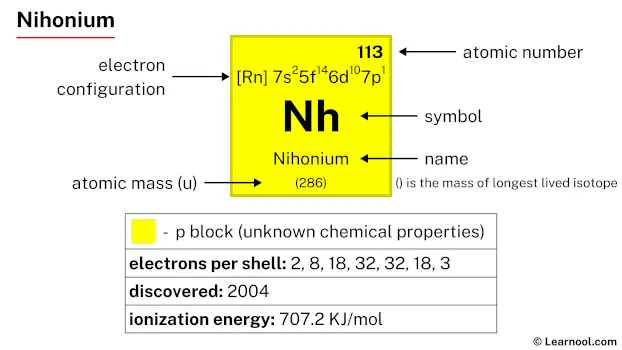 Nihonium |
114 Fl 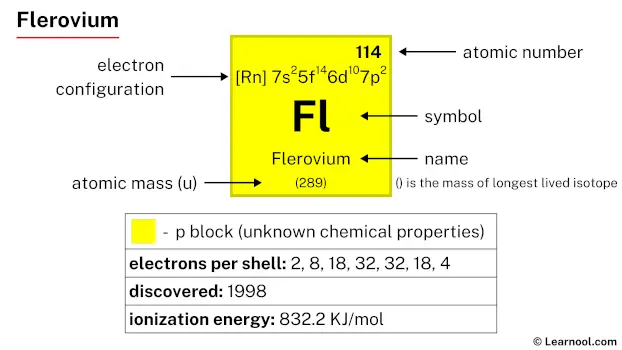 Flerovium |
115 Mc 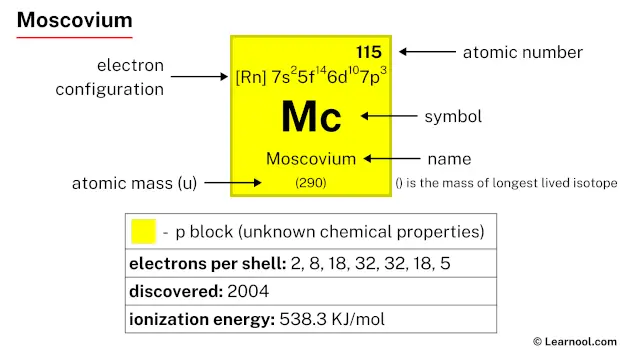 Moscovium |
116 Lv 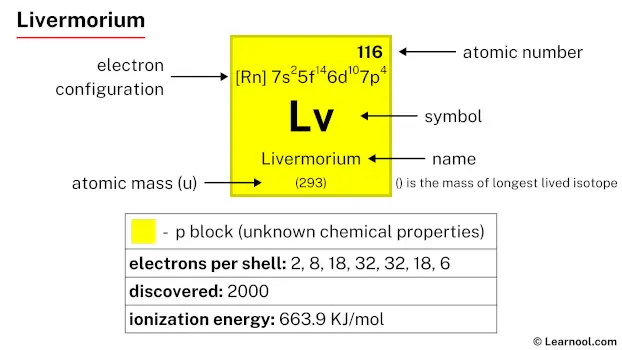 Livermorium |
117 Ts 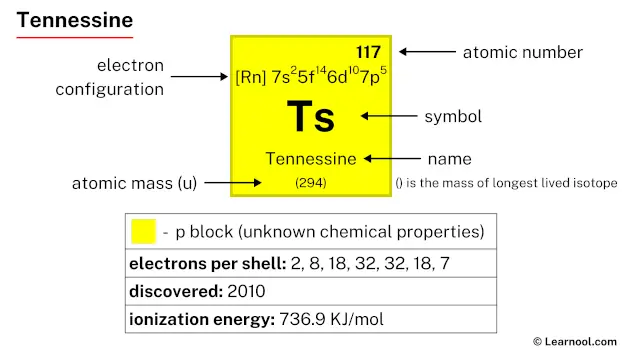 Tennessine |
118 Og Oganesson |
||
| 57 La 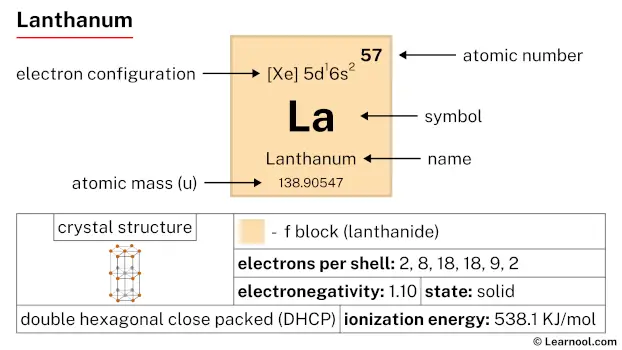 Lanthanum |
58 Ce 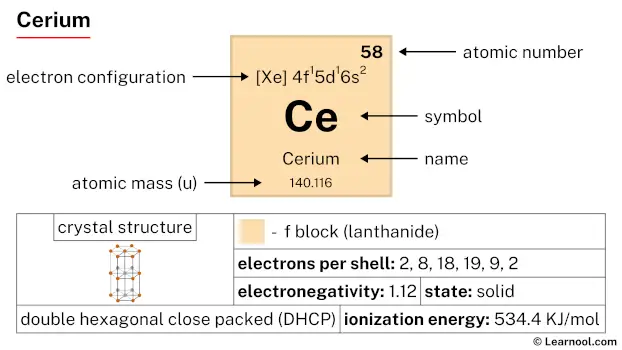 Cerium |
59 Pr 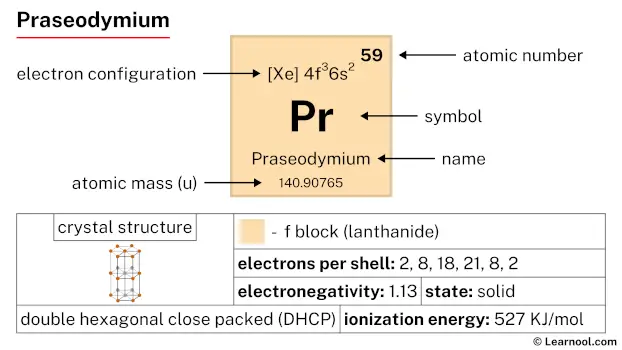 Praseodymium |
60 Nd 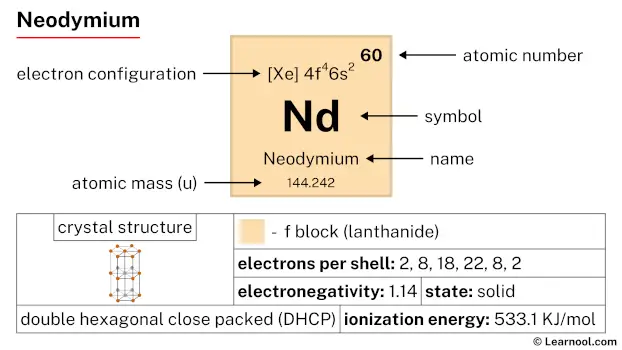 Neodymium |
61 Pm 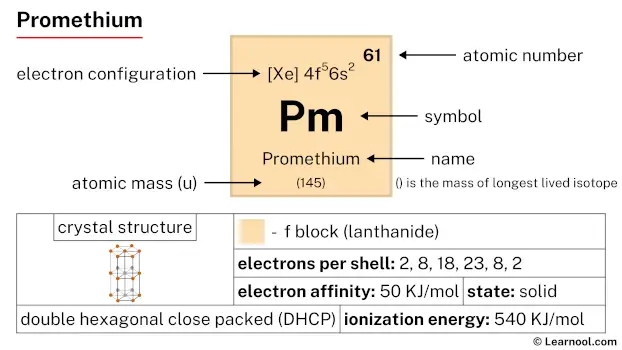 Promethium |
62 Sm 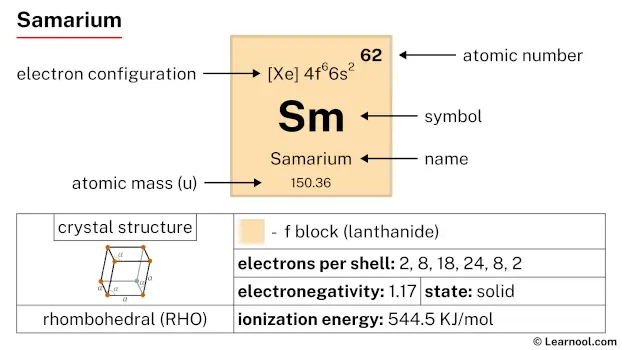 Samarium |
63 Eu 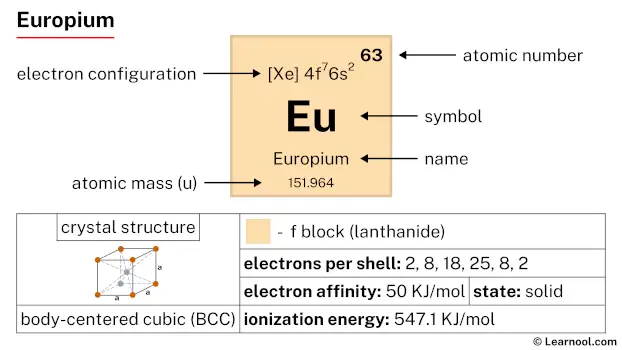 Europium |
64 Gd 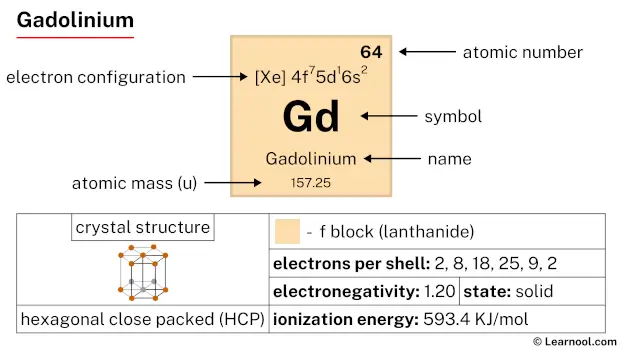 Gadolinium |
65 Tb 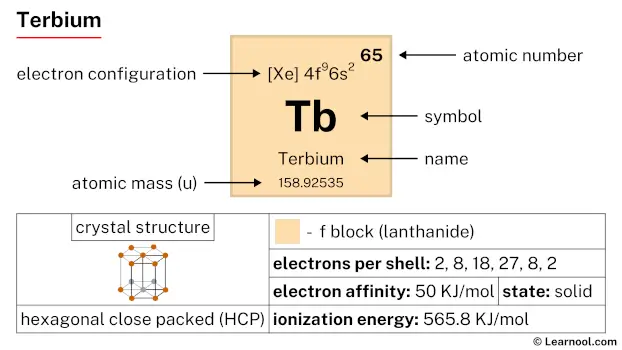 Terbium |
66 Dy 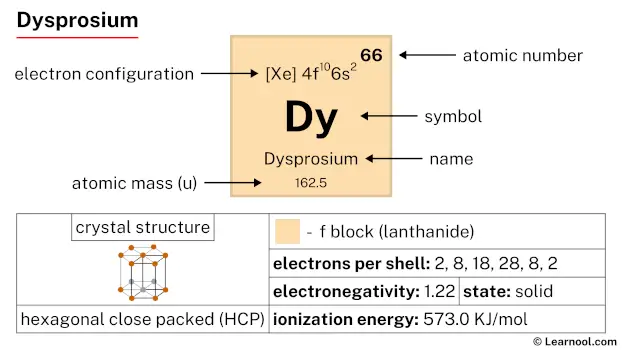 Dysprosium |
67 Ho 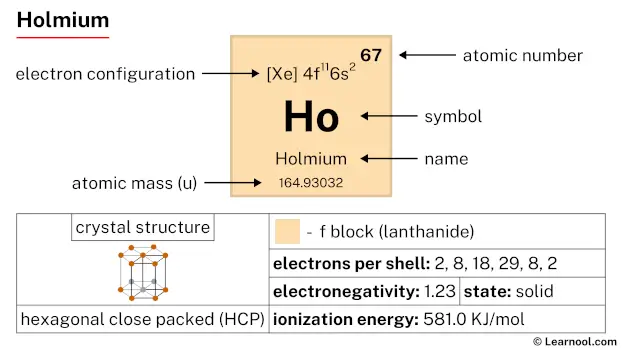 Holmium |
68 Er 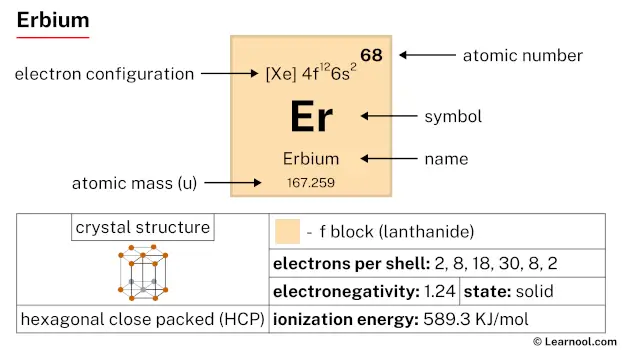 Erbium |
69 Tm 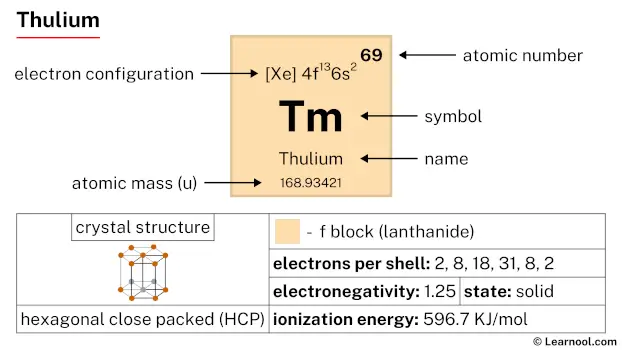 Thulium |
70 Yb 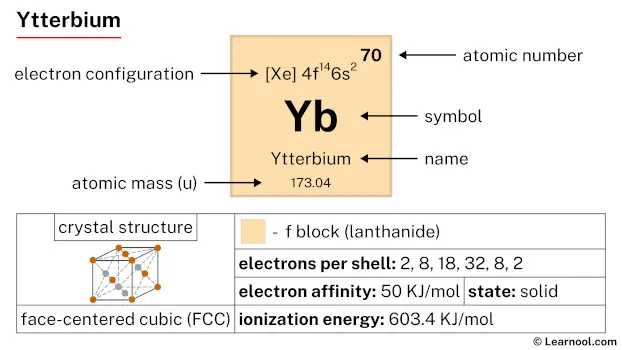 Ytterbium |
71 Lu 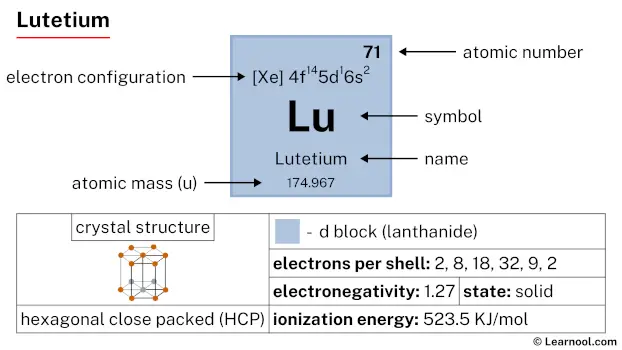 Lutetium |
|||||
| 89 Ac 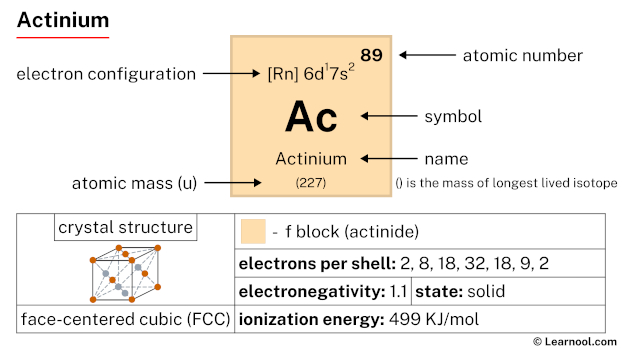 Actinium |
90 Th 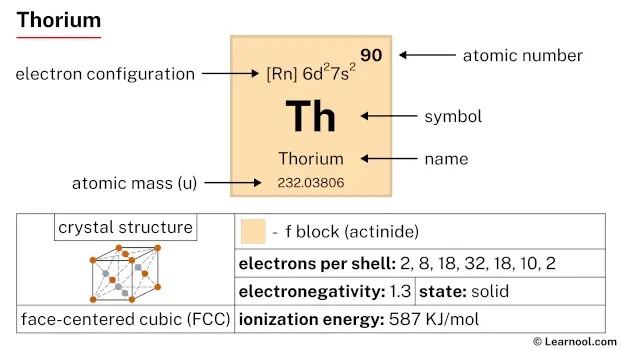 Thorium |
91 Pa 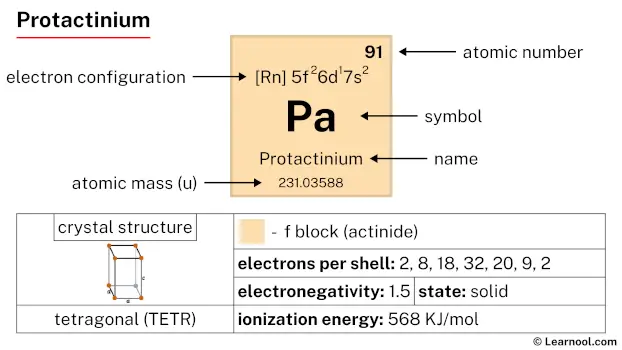 Protactinium |
92 U 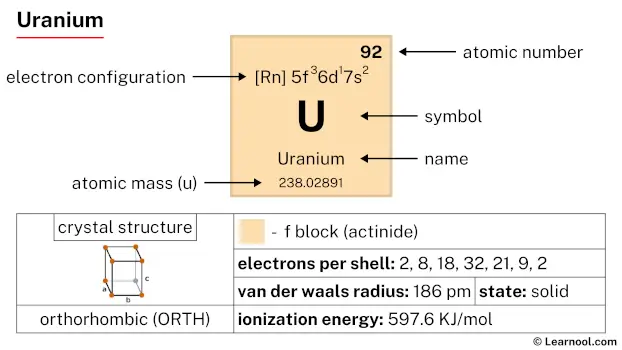 Uranium |
93 Np 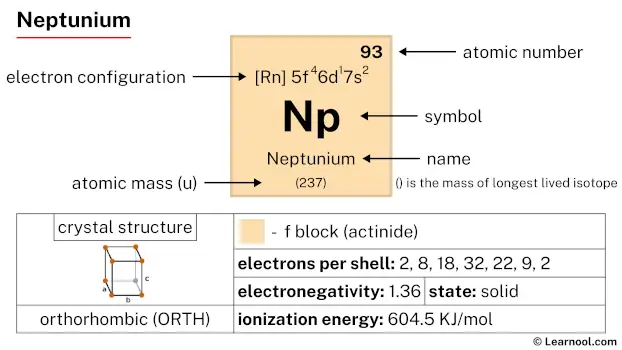 Neptunium |
94 Pu 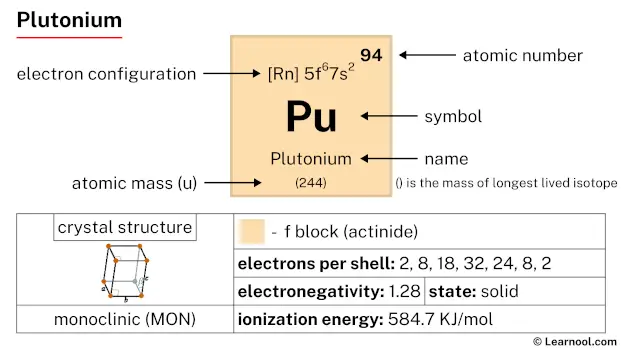 Plutonium |
95 Am  Americium |
96 Cm 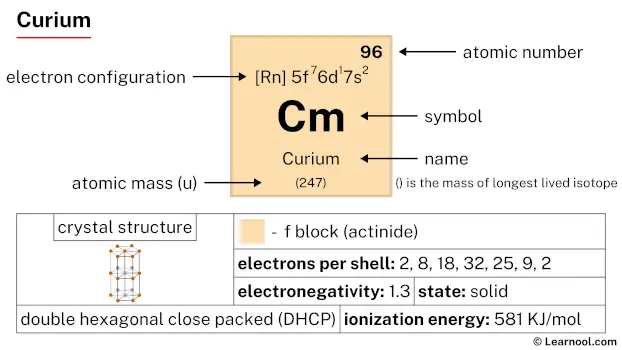 Curium |
97 Bk 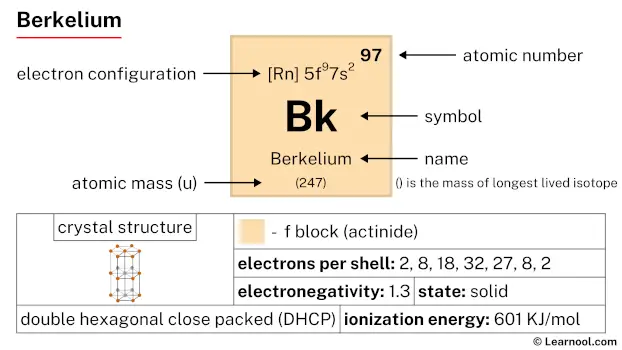 Berkelium |
98 Cf 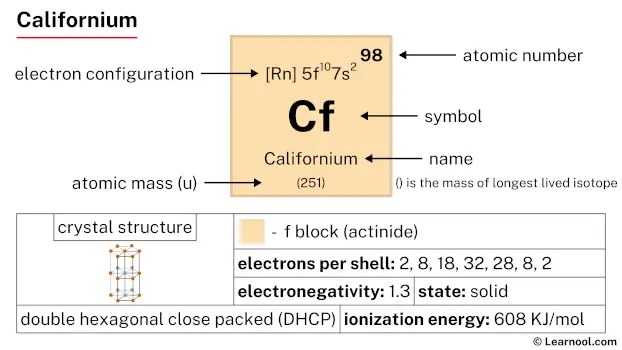 Californium |
99 Es 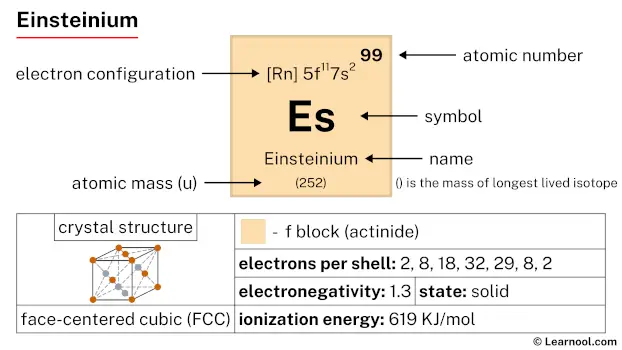 Einsteinium |
100 Fm 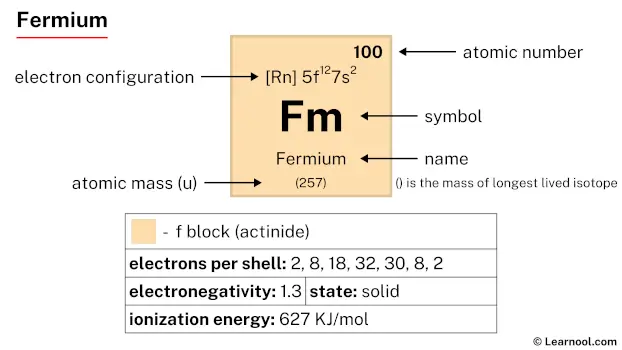 Fermium |
101 Md 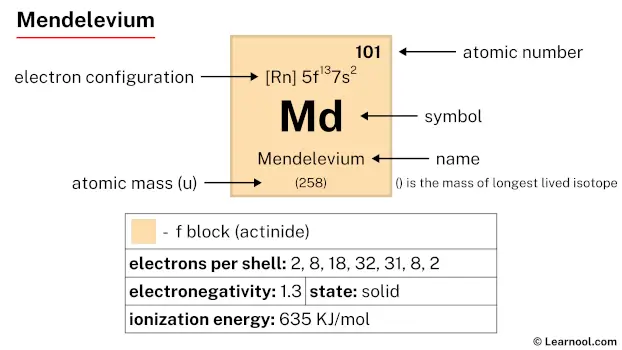 Mendelevium |
102 No 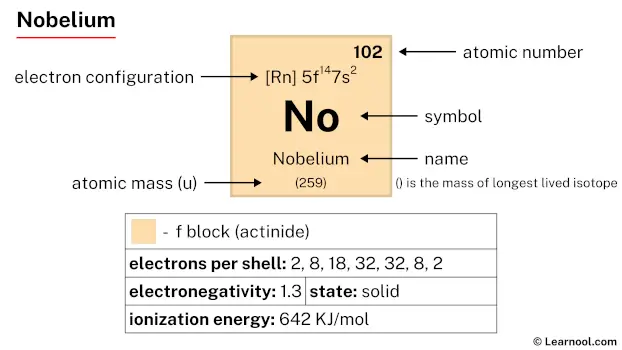 Nobelium |
103 Lr 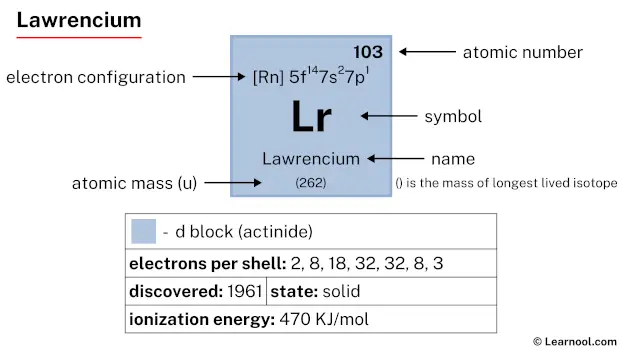 Lawrencium |
|||||
| – p block |
Oganesson is a p-block element, situated in the eighteenth column of the periodic table, next to tennessine (Ts). It has the atomic number 118 and is denoted by the symbol Og.
Element information
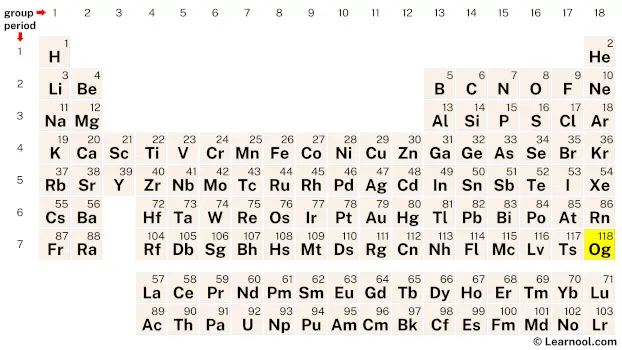 |
|
| Origin of name | named after Russian nuclear physicist, Yuri Oganessian |
| Symbol | Og |
| Atomic number (Z) | 118 |
| Atomic mass | (294) |
| Block | p-block |
| Group | 18 |
| Period | 7 |
| Classification | Unknown chemical properties |
| Atomic radius | 152 pm (predicted) |
| Covalent radius | 157 pm (predicted) |
| Melting point | 52±15 ℃, 125±27 ℉, 325±15 K (predicted) |
| Boiling point | 177±10 ℃, 350±18 ℉, 450±10 K (predicted) |
| Electron configuration | [Rn] 5f14 6d10 7s2 7p6 (predicted) |
| Electrons per shell | 2, 8, 18, 32, 32, 18, 8 (predicted) |
| Crystal structure | Face-centered cubic (fcc) (extrapolated) |
| Phase at r.t | Solid (predicted) |
| Density near r.t | 7.2 g/cm3 (calculated) |
| Natural occurrence | Synthetic |
| Oxidation state | +2 (predicted), +4 (predicted) |
| Protons Neutrons Electrons |
118 176 118 |
| Valence electrons | 8 |
| CAS number | 54144-19-3 |
| Discovered at | Joint Institute for Nuclear Research (JINR) and Lawrence Livermore National Laboratory (LLNL) in 2002 |
History
Oganesson was first synthesized in 2002 by a joint team of Russian and American scientists at the Joint Institute for Nuclear Research (JINR) in Dubna, Russia, and Lawrence Livermore National Laboratory (LLNL) in California, USA. The team included Yuri Oganessian, after whom the element was named.
In 1999, a team at the Lawrence Berkeley National Laboratory in California claimed to have discovered element 118, but their results could not be replicated, and the team retracted their claim. In 2002, the Dubna team succeeded in creating a single atom of oganesson by firing a beam of calcium-48 ions at a target made of californium-249, resulting in the nuclear reaction that produced oganesson.
The discovery of oganesson was officially announced in 2006 by both the Dubna team and the LLNL team, who had been working with the Dubna scientists. In December 2015, the Joint Working Party of international scientific bodies International Union of Pure and Applied Chemistry (IUPAC) and International Union of Pure and Applied Physics (IUPAP) recognized the element’s discovery and assigned the priority of the discovery to the Dubna-Livermore collaboration.
Since its discovery, oganesson has been the subject of ongoing research to determine its properties and potential uses. However, due to its short half-life and unstable nature, there are currently no known practical applications for oganesson.
Occurrence and production
Oganesson is a synthetic and superheavy element that is not naturally occurring on Earth. It was first synthesized by a joint team of Russian and American scientists in 2002 by using a heavy-ion accelerator to fire a beam of calcium-48 ions at a target made of californium-249. The resulting nuclear reaction produced a single atom of oganesson, which was detected by a set of detectors surrounding the target.
Oganesson is the heaviest element that has been synthesized so far, and its most stable isotope, oganesson-294, has a half-life of only about 0.7 milliseconds. Due to its extreme instability, only a few atoms of oganesson have ever been produced, and it has no known practical applications.
The synthesis of oganesson is an incredibly complex and difficult process, and it requires a significant amount of energy to create even a few atoms. As a result, it is currently produced only in specialized laboratories using expensive and advanced equipment.
In recent years, new methods have been proposed for the synthesis of oganesson, including the use of new isotopes of target materials and the optimization of reaction conditions. However, due to the extreme instability of oganesson and its short half-life, it remains a challenging element to study and produce.
Properties
Physical properties
Oganesson is a highly unstable element and has never been seen in its elemental form.
Due to its short half-life, the physical properties of oganesson are not well-known.
It is expected to be a noble gas, possibly even a member of the noble gas group, due to its high atomic number.
Chemical properties
Oganesson is predicted to be a highly reactive element and form chemical bonds with other elements.
Its reactivity is thought to be similar to that of the other elements in group 18 of the periodic table, such as helium, neon, and argon.
It is possible that oganesson could form compounds with other elements, but this has not been observed experimentally.
Electronic properties
Oganesson has a closed-shell electronic configuration, with a filled 7p subshell.
It is expected to have very weak metallic or non-metallic properties due to its high atomic number and electron configuration.
Theoretical calculations suggest that oganesson could have metallic properties at extremely high pressures.
Applications
Currently, there are no known applications for oganesson due to its incredibly short half-life and unstable nature. The element has only been produced in minute quantities and is extremely difficult to study. Additionally, its properties have not been fully characterized, making it challenging to predict potential applications.
However, the discovery of oganesson and other superheavy elements contributes to our understanding of nuclear physics and the behavior of matter at extreme conditions. It also opens up the possibility for future discoveries and advances in the field of nuclear science.
Interesting facts
Oganesson is one of the heaviest elements known to exist, with an atomic number of 118.
Oganesson is a member of the noble gas family, which means it is generally unreactive and does not form compounds easily.
Oganesson has the shortest known half-life of any element, with most isotopes lasting only fractions of a second.
Oganesson is sometimes referred to as “superheavy hydrogen” because it is believed to have similar chemical properties to hydrogen, despite being much heavier.
The discovery of oganesson was the result of a collaboration between Russian and American scientists, with the element being named after Russian physicist Yuri Oganessian.
Oganesson is not known to have any practical applications due to its short half-life and unstable nature.
Oganesson is one of only a handful of elements that are not naturally occurring and must be synthesized in a laboratory.
Related
More elements
External links
- https://en.wikipedia.org/wiki/Oganesson
- https://www.rsc.org/periodic-table/element/118/oganesson
- https://www.britannica.com/science/element-118
- https://pubchem.ncbi.nlm.nih.gov/element/Oganesson
- https://www.livescience.com/41460-facts-about-ununoctium.html
- https://education.jlab.org/itselemental/ele118.html
- https://www.chemicool.com/elements/oganesson.html
- https://www.acs.org/content/acs/en/molecule-of-the-week/archive/o/oganesson.html
Deep
Learnool.com was founded by Deep Rana, who is a mechanical engineer by profession and a blogger by passion. He has a good conceptual knowledge on different educational topics and he provides the same on this website. He loves to learn something new everyday and believes that the best utilization of free time is developing a new skill.
